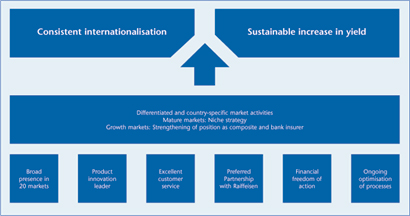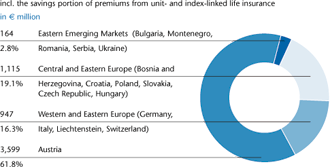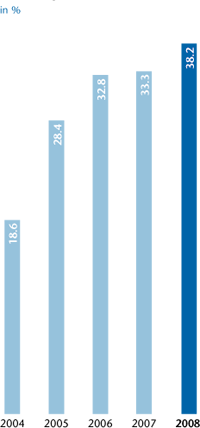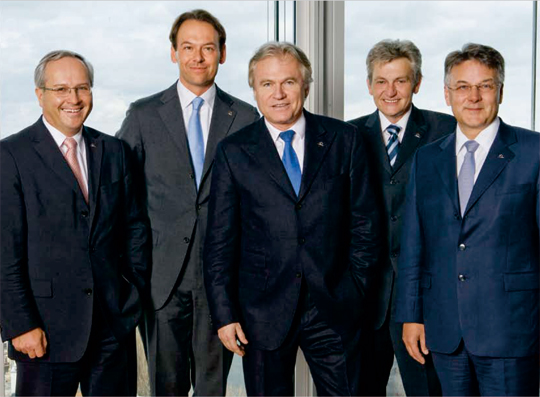Profitable International GrowthConsistent internationalisation and a sustainable increase in
yield – these are the core goals of the UNIQA Group’s
expansion strategy. The Group continued persistently with
this strategy in 2008 despite the fact that the economic
environment on the financial markets had become considerably
more difficult by the end of the year.
The UNIQA Group continues to pursue its top-level goals – even
in the considerably harsher environment since the outbreak of
the international financial and economic crisis. Visible proof of
the success of our concerted efforts to implement our growth
strategy in 2008 was, once again, the above-average growth in
premium volume by a total of 10.4% to €5,825 million and
above all of the premium revenue in Eastern Europe by 56.7%
to €1,279 million. On the other hand, profit (before taxes) sank
to €90 million because of the economic crisis and mainly due
to the turbulences on the financial markets. Given these developments,
the UNIQA Group has also postponed its mediumterm
forecast until further notice.
Strong presence in Central, Eastern and South Eastern Europe
Targets and core strategies remain unchangedThe central strategic concern of the UNIQA Group is to preserve
its strong position in the Central and Eastern European markets
in times of tough competition and increasing globalisation. This
should make it possible for the Group to operate successfully in
the largely saturated markets in Austria and Central Europe while
at the same time actively taking advantage of the historic opportunities
presented by the exceptionally dynamic regions
encompassing 360 million people within and beyond the eastern
borders of the EU.
 |
In implementing
these goals,
UNIQA is pursuing
the following
basic strategic
approaches, and
has laid them out
in operational
action plans. |
The Group defined a target for average (pre-tax) return on equity
of at least 20% as a guide to ensure successful implementation
of its strategy; up until now, the medium-term forecast for the
result was €430 million by 2010. However, in light of the volatile
market environment, as already mentioned, this has been postponed
until further notice.
As far as continuing the Group’s internationalisation is concerned,
UNIQA aims in the medium term to bring the share of international
premiums within the entire Group’s premium volume up
to 50%. Of this amount, a considerable percentage should come
from Eastern Europe. In addition, the company has set concrete
medium-term targets for the respective market shares in the
various growth markets in Central, Eastern and South Eastern
Europe.
Well-positioned in Central, Eastern andWith 40 insurance companies in a total of 20 markets, a premium revenue of €5.8 billion and investments amounting to over €21 billion, UNIQA has managed to position itself in only a few years as one of the leading market players in Central, Eastern and South Eastern Europe. In the past few years, the Group was able to expand its sphere of activities in South Eastern Europe to include Albania, Macedonia and Kosovo. At the same time, by expanding its financial commitment in Bulgaria and Ukraine, it was able to further strengthen its position in these quickly growing markets.
The most recent highlight of this expansion was in November 2008 with the 100% takeover of UNITA, the sixth-largest Romanian property insurer, giving UNIQA a market share of over 7% in one of the largest markets in the European East in one swoop. International business becoming increasingly
Premium volume 2008 by region |

|
The markets in Central, Eastern and South Eastern Europe currently
contribute 22% to the premium revenue of the UNIQA
Group; in 2008, the total portion of premiums generated by all
international business was over 38% and should be rising even
more. With this increasing internationalisation of business volume
as well as the Group results, the Group is not only diversifying
the risks of its corporate portfolio both regionally and by
product groups and distribution channels, it is also laying the
foundation for fulfilling its ambitious growth targets.
Growing share of international business |

|
In the process, the UNIQA Group is pursuing differentiated strategies in the
various regions: In Austria, UNIQA wants to maintain its strong
position with segment-focused qualitative growth and higher returns. The Western
European markets, characterised by higher insurance density, contributed
roughly 16% of the Group premiums in 2008. The Group holds profitable niches
in these markets and succeeds through exclusive offerings in individual distribution
channels such as bank and broker sales. In Central, Eastern and South
Eastern Europe, the UNIQA Group is relying not only on the optimisation
of its financial commitment but also on a targeted increase of its market shares
and on a partnership-oriented acquisition of the majority of its various associated
companies. Ongoing expansion of market presence in CEE
In order to expand its position in the new markets in a focused
manner, UNIQA launched a series of dynamisation projects in
sales. The goal is to increase the various market shares in the
non-life sector to between 5% and 7% and in the life insurance
sector to 3%. This expansion of market presence is accompanied
by a uniform brand and marketing concept throughout the
Group as well as shared policies in IT, human resources and
management training. Successful partnership with RaiffeisenIn penetrating the new insurance markets, the “Preferred Partnership”
with the Raiffeisen bank group has proved to be very
valuable. The cooperation is an efficient sales channel that now
covers 13 countries in Eastern and South Eastern Europe; all of
these areas are still highly underdeveloped, both in insurance
and banking. This means that both partners profit from the cooperation,
which also promises to continue bringing aboveaverage
growth levels in the future. Since 2004, the first year of
this cooperation, the premium volume generated together has
increased to over €380 million in the year 2008.
 |
The “Preferred Partnership” with Raiffeisen
International has proven to be very valuable in a
number of markets in Eastern and South Eastern Europe. |
Innovative leadership ensures a competitive
“International growth and a
sustainable increase in yields
made possible by excellent
performance, innovative leadership
and ongoing optimisation;
these are our central
goals – yesterday, today
and tomorrow.”
Konstantin Klien, Chairman of the Management Board |
As it expands, the UNIQA Group will continue to persistently
leverage its strengths as a product pioneer and innovation
leader. The company will continue its approach of laying claim
to certain topics of the future, thereby confirming its reputation
as a trendsetter over the long term.
UNIQA can look back on a long tradition of innovative product
design, giving it an obvious competitive advantage on the market.
Recent examples of this are the first kilometre-dependent
motor vehicle insurance with additional safety features and a
highly innovative product for long-term old-age pensions, which
blends elements of classic and unit-linked life insurance with a completely new level of flexibility so that it can be adapted at
any time to the current needs of the customer. As market leader
in health insurance, UNIQA set new standards by combining
extensive medical insurance protection with effective preventive
measures and useful assistance services. Innovative services for
premium category customers, customised offers for children
and packages for expatriates round off the portfolio. Promoting customer loyalty with differentiated
Innovative products are supplemented by a broad range of service instruments
that create an attractive added value for customers, binding them more strongly
to the company. In this way, UNIQA proves its high level of expertise in developing
products with additional value and unique selling points in the market. This
reinforces the brand’s image and aids both the acquisition of new customers
and targeted cross-selling in the sense of a “total customer” strategy. Offers
such as the extensive information service UNIQA Companion,
the UNIQA QualityPartnership and the extremely popular weather
warnings by SMS and e-mail have all been very well received.
As an additional success factor, UNIQA cultivates the capability
of its employees to find innovative solutions by providing ongoing
training as part of its customised staff development
programmes. The outstanding quality of the Group’s human
capital on all levels is essential for the successful implementation
of its corporate strategy, which is why it is constantly refined
and developed through aggressive personnel management. This
includes flexibility and mobility across country borders. EBRD expands financial optionsAn important factor in UNIQA’s expansion in Eastern Europe is
provided by the European Bank for Reconstruction and Development
(EBRD). In 2007, the EBRD increased the scope of its
financial cooperation with the Group from the previous €70
million to the current €150 million. This provides UNIQA with
noticeably more funds for minority investments by the EBRD in
UNIQA companies in Central and Eastern Europe. Consistent process optimisation
Further potential for sustainable expansion has been created
with UNIQA’s third Profit Improvement Programme 2007–2010.
It should bring a clear improvement in the profit on ordinary
activities by 2010. To this end, UNIQA has developed concrete
action plans, making an effort to noticeably lower the claim and
cost ratios even further, to compress structures, eliminate redundant
work in the corporation and save money by outsourcing
certain tasks to international Group companies. The Management Board of UNIQA Versicherungen AG
 Hannes Bogner, Andreas Brandstetter, Konstantin Klien, Karl Unger, Gottfried
Wanitschek (from left to right)
Hannes Bogner, Andreas Brandstetter, Konstantin Klien, Karl Unger, Gottfried
Wanitschek (from left to right)
|
Hannes Bogner
Member of the
Management Board
- Born in 1959
- Academic background:
Business administration
Hannes Bogner has been
with the UNIQA Group
since 1994 and was appointed
to the Management
Board in 1998. Prior
to this, he worked at THS
Treuhand Wirtschaftsprüfungsgesellschaft
in
Salzburg and at PwC
PricewaterhouseCoopers in
Vienna. Mr. Bogner became
a tax consultant in 1988
and a chartered accountant
in 1993.
Responsible for:
Group
accounting, planning
and controlling, asset
management (back office),
investor relations,
industry customers and
reinsurance policy
Country responsibility:
Germany, Italy, Poland,
Switzerland
Andreas Brandstetter
Member of the
Management Board
- Born in 1969
- Academic background:
Political science and
history
Dr. Brandstetter joined
the Group in 1997 and
was responsible for the
restructuring of UNIQA
Versicherungen AG in
1999; he was appointed
to the Management Board
in 2002. Before that, he
was head of the EU office
of the Austrian Raiffeisenverband
in Brussels and
completed the MBA programme
at the California
State University.
Responsible for:
New
markets, mergers &
acquisitions, bank sales
policy
Country responsibility:
Albania, Bulgaria,
Kosovo, Macedonia,
Montenegro, Romania,
Russia, Serbia, Slovenia,
Ukraine
Konstantin Klien
Chairman of the
Management Board
- Born in 1951
- Academic background:
Economics
Dr. Klien joined the UNIQA
Group in October 2000
as Vice Chairman of the
Management Board.
Since 1 January 2002,
he has been Chairman of
the Management Board
and CEO of UNIQA
Versicherungen AG.
Dr. Klien began his professional
career at Arthur
Andersen and transferred
to Nordstern Versicherung
in 1978, where he was
appointed to the
Management Board in
1986. In 1991, he became
Chairman of the Board of
the holding company AXA
Austria and also exercises
executive functions for the
AXA companies in Central
Europe since 1995.
Responsible for:
Group
management, sales,
planning and controlling,
human resources,
marketing, communications,
investor relations,
internal auditing
Country responsibility:
Austria
Karl Unger
Member of the
Management Board
- Born in 1953
- Academic background:
Actuarial mathematics
Karl Unger began his professional
career in 1979 as
an actuary at Volksfürsorge
Versicherung. He later
transferred to Nordstern
Versicherung, where he was
appointed to the Management
Board in 1994 and
took over the life insurance
department. In 1999, Karl
Unger took on responsibility
for Central Europe within
the AXA Group. He switched
to UNIQA in 2001 as head
of the administrative department
for corporate
planning and joined the
Management Board of
UNIQA Versicherungen AG
in 2002.
Responsible for:
Private
customer business, IT,
company organisation,
customer service, Group
actuarial office, risk
management
Country responsibility:
Liechtenstein, Hungary,
Slovakia
Gottfried Wanitschek
Member of the
Management Board
- Born in 1955
- Academic background:
Law
Dr. Wanitschek started working in the insurance business back in the eighties
and was first head of the legal office and later secretary general of Raiffeisen
Versicherung AG. From 1991 until he was appointed to the Management Board of
UNIQA Versicherungen AG in 1997, he was director of Beteiligungsholding Leipnik-Lundenburger
Industrie AG, managing director of Kurier GmbH, member of the executive management
at Mediaprint and director of Zeitschriften-Verlagsbeteiligungs-AG.
Responsible for:
Asset
management (front
office), equity holdings,
property management,
legal affairs, general
administration, internal
auditing
Country responsibility:
Bosnia and Herzegovina,
Croatia, Czech Republic
| 

 Group 2008
Group 2008 Strategy
Strategy









 Contact
Contact


